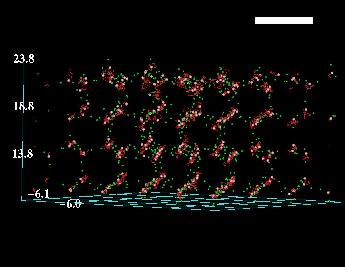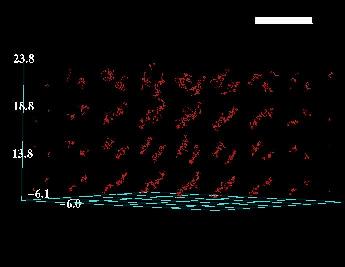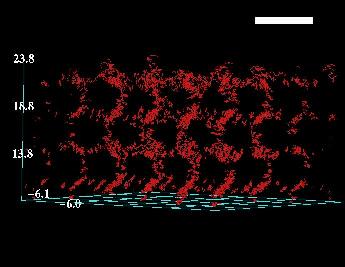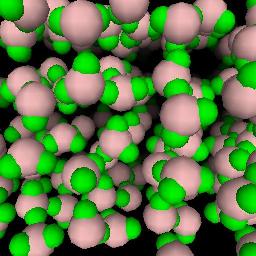This is an archival copy of the Visualization Group's web page 1998 to 2017. For current information, please vist our group's new web page.
Simulation of Ice at 150K
The overall goal of this visualization is to highlight the differences between "layers" of molecular movement. In particular, molecules closer to the surface (towards the top of the picture) appear to move more than those further away from the surface (lower in the picture).
Accumulated motion is represented by attaching a "tail" to the oxygen atom of each molecule. First, we tried attaching a tail to each atom of each molecule, but feel that decluttering the image by reducing the number of visible tails helps in interpretation. Each tail shows the position of the atom over the last 50 timesteps. In the case in which an atom's position "wraps" around the grid (which is periodic), the tail accumulation is reset.
 |
Tails Only
Here are two more sequences in which the spheres-per-atom have been completely removed leaving us with only the tails. One sequence has a tail-per-atom, the other has a tail-per-oxygen (less tails overall).
| |
|
 |
 |
| |
|
In the simulation, the water molecules are arranged in 8 layers (4 bilayers) of 30 (60) molecules. The lowest layer is superimposed on a fixed slab of 4 layers of fixed water molecules, those are not shown. The simulation generates atomic positions over a 10 ps window at 10 fs intervals.
The coordinates of the water molecule atoms are in Angstroms. Due to the use of periodic boundary conditions in x and y, it may occasionally happen that a molecule "disappears" on the left or right (top or bottom), and reappears on the right or left (bottom or top).
 |
1000 Frame MPEG movie (23Mbytes)
Acknowledgement
- Ayman Al-Halabi, LIC, Gorlaeus Laboratoria, Rijksuniversiteit Leiden, The Netherlands
- G.J. Kroes, LIC, Gorlaeus Laboratoria, Rijksuniversiteit Leiden, The Netherlands
- Michel Van Hove, Materials Sciences Division, Lawrence Berkeley National Laboratory